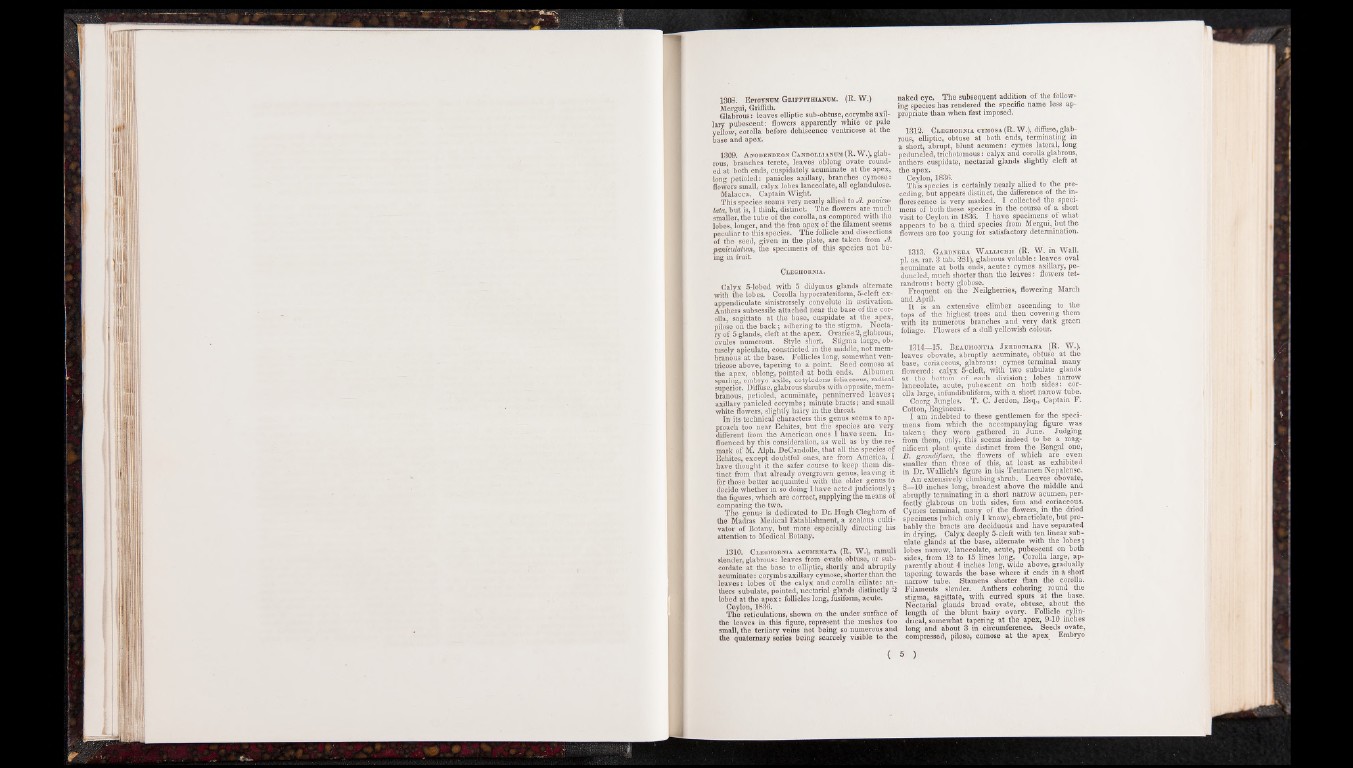
1308. Epigynum Griffithianctm. (R. W.)
Mergui, Griffith.
Glabrous: leaves elliptic sub-obtuse,corymbs axillary
pubescent: flowers apparently white or pale
yellow, corolla before dehiscence ventricose at the
base and apex.
1309. Anodendeon Candollianum (R. W.), glabrous,
branches terete, leaves oblong ovate rounded
at both ends, cuspidately acuminate at the apex,
long petioled: panicles axillary, branches cymose:
flowers small, calyx lobes lanceolate, all eglandulose.
Malacca. Captain Wight.
This species seems very nearly allied to A. paniculate,
but is, I think, distinct. The flowers are much
smaller, the tube of the corolla, as compared with the
lobes, longer, and the free apex of the filament seems
peculiar to this species. The follicle and dissections
of the seed, given in the plate, are taken from A.
paniculatum, the specimens of this species not being
in fruit.
Cleghornia.
Calyx 5-lobed with 5 didymus glands alternate
with the lobes. Corolla hypocrateriform, 5-cleft ex-
appendiculate sinistrorsely convolute in aestivation.
Anthers subsessile attached near the base of the corolla,
sagittate at the base, cuspidate at the apex,
pilose on the back; adhering to the stigma. Nectary
of 5 glands, cleft at the apex. Ovaries 2, glabrous,
ovules numerous. Style short. Stigma large, obtusely
apiculate, constricted in the middle, not membranous
at the base. Follicles long, somewhat ventricose
above, tapering to a point. Seed comose at
the apex, oblong, pointed at both ends. Albumen
sparing, embryo axile, cotyledons foliaceous, radical
superior. Diffuse, glabrous shrubs with opposite, membranous,
petioled, acuminate, penninerved leaves;
axillary panicled corymbs; minute bracts; and small
white flowers, slightly hairy in the throat.
In its technical characters this genus seems to approach
too near Echites, but the species are very
different from the American ones I have seen. Influenced
by this consideration, as well as by the remark
of M. Alph. DeCandolle, that all the species of
Echites, except doubtful ones, are from America, I
have thought it the safer course to keep them distinct
from that already overgrown genus, leaving it
naked eye. The subsequent addition of the following
for those better acquainted with the older genus to
decide whether in so doing I have acted judiciously;
the figures, which are correct, supplying the means of
comparing the two.
The genus is dedicated to Dr. Hugh Cleghorn of
the Madras Medical Establishment, a zealous cultivator
of Botany, but more especially directing his
attention to Medical Botany.
1310. Cleghornia acumenata (R. W.), ramuli
slender, glabrous: leaves from ovate obtuse, or sub-
cordate at the base to elliptic, shortly and abruptly
acuminate: corymbs axillary cymose, shorter than the
leaves: lobes of the calyx and corolla ciliate: anthers
subulate, pointed, nectarial glands distinctly 2
lobed at the apex: follicles long, fusiform, acute.
Ceylon, 1836.
The reticulations, shown on the under surface of
the leaves in this figure, represent the meshes too
small, the tertiary veins not being so numerous and
the quaternary series being scarcely visible to the
species has rendered the specific name less appropriate
than when first imposed.
1312. Cleghornia cymosa (R. W.), diffuse, glabrous,
elliptic, obtuse at both ends, terminating in
a short, abrupt, blunt acumen: cymes lateral, Tong
peduncled, trichotomous: calyx and corolla glabrous,
anthers cuspidate, nectarial glands slightly cleft at
the apex.
Ceylon, 1836.
T his species is certainly nearly allied to the preceding,
but appears distinct, the difference of the inflorescence
is very marked. I collected the specimens
of both these species in the course of a short
visit to Ceylon in 1836. I have specimens of what
appears to be a third species from Mergui, but the
flowers are too young for satisfactory determination.
1313. Gardnera Wallichii (R. W. in Wall,
pi. as. rar. 3 tab. 281), glabrous voluble: leaves oval
acuminate at both ends, acute: cymes axillary, peduncled,
much shorter than the lea v e s: flowers tet-
randrous: berry globose.
Frequent on the Neilgherries, flowering March
and April.
It is an extensive climber ascending to the
tops of the highest trees and then covering them
with its numerous branches and very dark green
foliage. Flowers of a dull yellowish colour.
1314—15. Beaumontia J erdoniana (R. W.),
leaves obovate, abruptly acuminate, obtuse at the
base, coriaceous, glabrous: cymes terminal many
flowered: calyx 5-cleft, with two subulate glands
at the bottom of each division; lobes narrow
lanceolate, acute, pubescent on both sides: corolla
large, infundibuliform, with a short narrow tube.
Coorg Jungles. T. C. Jerdon, Esq., Captain F.
Cotton, Engineers.
I am indebted to these gentlemen for the specimens
from which the accompanying figure was
taken; they were gathered in June. Judging
from them, only, this seems indeed to be a magnificent
plant quite distinct from the Bengal one,
B . grandiflora, the flowers of which are even
smaller than those of this, at least as exhibited
in Dr. Wallich’s figure in his Tentamen Nepalense.
An extensively climbing shrub. Leaves obovate,
8—10 inches long, broadest above the middle and
abruptly terminating in a short narrow acumen, perfectly
glabrous on both sides, firm and coriaceous.
Cymes terminal, many of the flowers, in the dried
specimens (which only I know), ebractiolate, but probably
the bracts are deciduous and have separated
in drying. Calyx deeply 5-cleft with ten linear subulate
glands at the base, alternate with the lobes;
lobes narrow, lanceolate, acute, pubescent on both
sides, from 12 to 15 lines long. Corolla large, apparently
about 4 inches long, wide above, gradually
tapering towards the base where it ends in a short
narrow tube. Stamens shorter than the corolla.
Filaments slender. Anthers cohering round the
stigma, sagittate, with curved spurs at the base.
Nectarial glands broad ovate, obtuse, about the
length o f the blunt hairy ovary. Follicle cylindrical,
somewhat tapering at the apex, 9-10 inches
long and about 3 in circumference. Seeds ovate,
compressed, pilose, comose at the apex_ Embryo